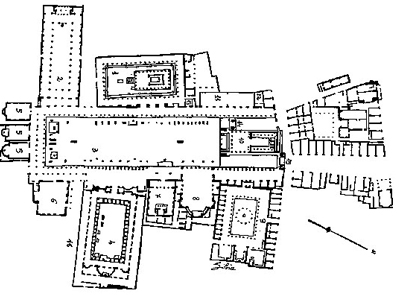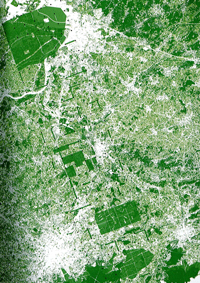You are in: Home page > Magazine Archive > The meaning of centrality

Paolo Strina
The meaning of centrality
Technique of densifying built space

Il foro di Pompei
This article investigates the term urban centrality, one of the key words of the 2013 Spinner Research Project: Designing the built: new models of integrated quality for the compact city, ongoing since 2012. Architecture has often had to deal with the meaning of urban centrality, interpreting it according to the evolutive dynamics that have gradually come to guide planning choices in urban development. The term centrality is to be understood in the sense of architectural typology, but in primis in the symbolic sense of its effect on the community, aggregation, and ultimately, the place itself. It becomes concrete within a complex settlement system that shapes a space of a centrifugal and centripetal type, both introvert and extrovert, that can hoard the memory of the context of belonging from whose formal characteristics it has drawn and, at the same time, build an identity memory of the community that inhabits and will continue to inhabit it.
“Centrality describes the action of a central element in its periphery. It was defined thus as a hierarchical concept between service and attraction by W.E. Christaller back in 1933. The attractiveness and circulation of this element is based on the efficacy of the central pole and its accessibility. This element may be an urban centre or a more specialist polarizing element (a shopping, cultural, financial, or administrative centre). Accessibility is a fundamental condition.”[1]
The technique of densifying the built space in the contemporary city can be classified in two categories: densification of the fabric, or densification through an urban centrality strategy.
The first case contributes to the consolidation or completion of the connective link between urban parts represented by the mostly residential fabric component and the built space.
To this end, the most consolidated intervention methods are: urban redevelopment by means of infill, replacement of buildings with an increase in volume, recovery of abandoned areas with an increase in volume, simple enlargement of existing volumes frequently due to so-called "parasitic architecture"[2]. Speaking of "the built", experimentation with densification and so-called anti-sprawl techniques, also touches on the sphere of abstraction. Suffice to think of the approaches proposed by Xaveer De Geyter in his essay, After Sprawl. The actions he theorized – shift, overlay, insert, hide, frame, found, connect, array, add – hark back to the dimension of architectural representation, the point of departure for new concrete applications. All words whose root expresses a strong desire to redesign the extant through actions on the actual fabric that are in some ways rather surgical. Experimentation on the built also leads to a use of new languages founded on key words such as writing, rewriting, overwriting, in which densification is often read as a completion or addition that redevelops incomplete architectural forms while preserving their traditional character and gene[3].
Instead, the second case contributes
to structuring the indistinct urban fabric, more or less dense, more or less
compact, more or less consolidated and, if suburban, often anonymous and
incomplete, through the inclusion of exceptional spatialities with a strong
degree of representativeness in a position to catalyse the sociality of the
polycentric city, regenerate the urban and social fabric, and restore physical
continuity between the contextual morphological and typological components by
activating a determined system of variable relations, case by case.
Consequently, urban centrality presents itself as punctuation within the
grammar of the city. In a concrete sense, it is a new typology of
public/private structure predominantly used by the public, strongly analogous
to a social condenser. In order to
realize it, it is possible to turn to new buildings of so-called spaces for centrality built but not erected,
consistent and within the existing patrimony, as well as taking advantage of
all the means belonging to the first densification technique.
Centrality, seen as
both a typological device and a place of identity, has adapted to the city
through two veins, both founded on urban densification and concentration.
The Forum, a place
for interchange in which is concentrated the administrative function of society
and the territory, summarizes the first. A typology in which prevails the form
of emptiness defined through composition of plastic objects that construct the confines.
The second typology is represented by the grand unitary architectural organisms, condensers of functions, activities, customs and meanings assimilable to the very idea of the city. Suffice to think of cities within cities; basilicas, Roman baths, fortifications, monasteries, aristocratic palaces of power, city halls; in the nineteenth-century city, services such as hospitals, museums, schools, exhibition pavilions, trade fair quarters, social condensers of the constructivist experience and buildings representing political power. In the specific case, the compositional device used for these buildings is employed and characterized through distribution of the related internal space according to an arrangement that is almost designed as if it were an urban interior. Their lesson is taken up in the modern buildings of L. I. Kahn, both in those with a central plan and in articulate architectural devices, e.g. the Media Convent or the Unitarian Church of Rochester, in which spatial centrality in their formal diagram equals a “question mark” i.e., at the centre of the community question.[4]
The centric space, of a nature that is both introvert and extrovert, derived from the aggregative system of urban centrality, is a regulatory element with respect to its surroundings, the neighbouring context and the urban situation it itself creates. Public space assumes a primary role within the typology of centrality that is simultaneously unitary, multiple, and transcalar. It settles within “a real enduring framework in support, as far as it can, of cartilage and connective tissue; (…) merely by starting from this skeleton (the city) it can be regulated to remain coherent with its role in development and contraction, in transformation and conservation of its compages.”[5]
Hence, generic centrality assumes various degrees of importance within the city and the urban structure according to the role it plays as regards the relations it triggers at the various scales and peculiarities of the space for centrality it settles in. An experience at an Erasmus Intensive Programme Design Workshop in Parma in 2013, allowed the application of the densification technique through the strategy of urban centrality within a neighbourhood of the city of Parma called Sant’Eurosia, like the shopping mall it is home to. This applied example is demonstrative of the poly-functionality sought within the urban device being pursued. The schools of architecture that took part (Nantes, Hamburg, Prague, Istanbul, Parma) jointly tackled an urban project following a complex functional programme inside an unoccupied area that was neither empty nor residual or interstitial but, instead, a planned urban void, the result of an ongoing urban plan. The workshop led to the delineation of a standard profile of urban centrality able to embrace all the blessings of the regenerating and at the same time “re-founding” element of urban parts through a design method based on the following points: settlement matrix, identification of strong points, composition and layout, orientation, articulation, relation between the parts, visibility and proportion of the spaces, relationships with the edges of the extant fabric, figurativeness.[6]
[1] P. Merlin, F.Choay, Dictionnaire de l'urbanisme et de l'aménagement, Paris, Puf , 2010
[2] S.Marini, Architettura Parassitaria. Strategie di riciclaggio per la città, Macerata, 2009
[3] B. Servino, Monumental Need, Syracuse, 2012
[4] M. Fumo, G. Ausiello, Louis I. Kahn. Architettura e Tecnica, Naples, 1996
[5] G. Canella, La Diffusione del Centro in Zodiac, no.13, Milan, 1995
[6] E. Prandi, Compact city 2.Erasmus intensive programme design workshop. Designing centrality, regenerating the suburbs, Parma, 2014














